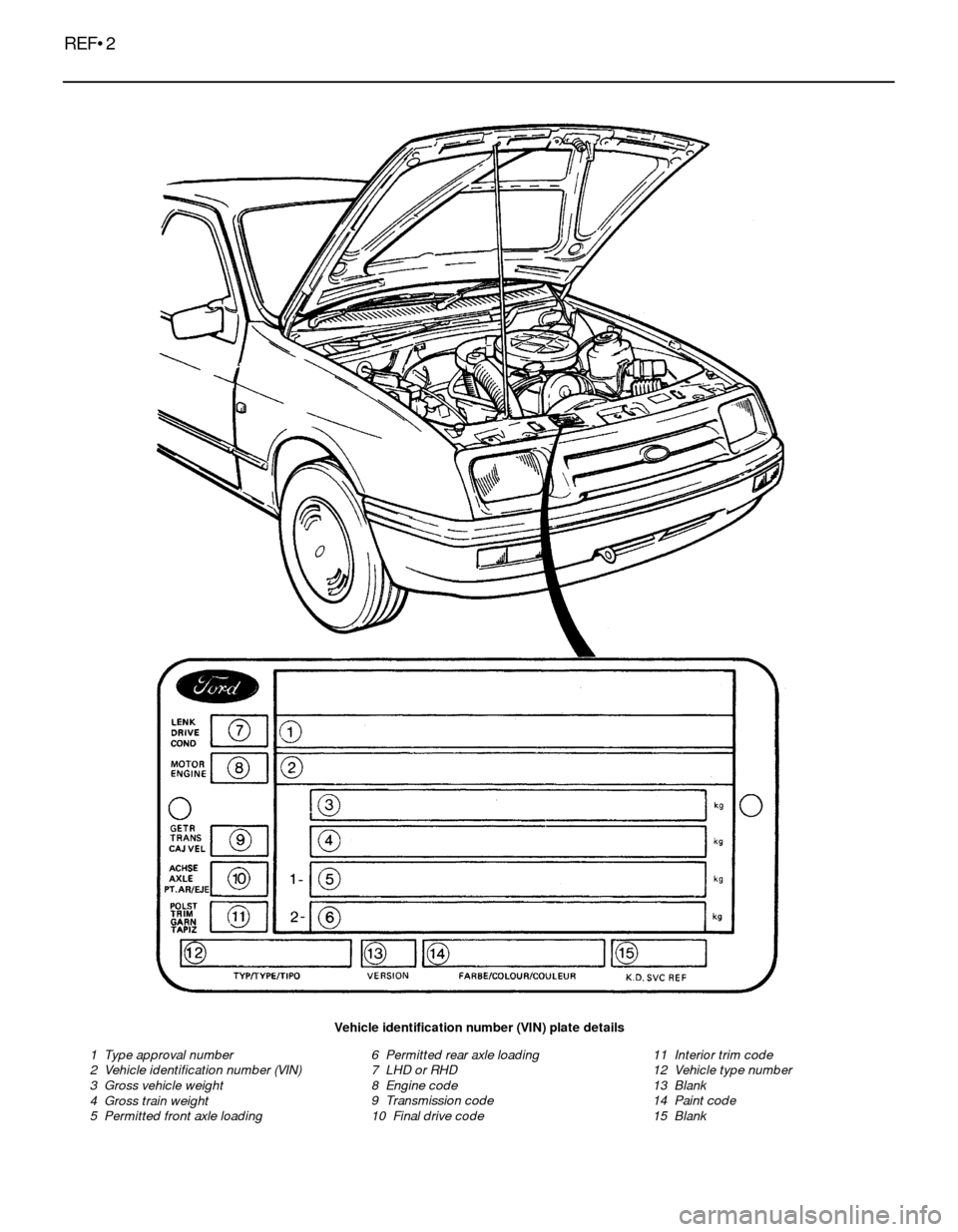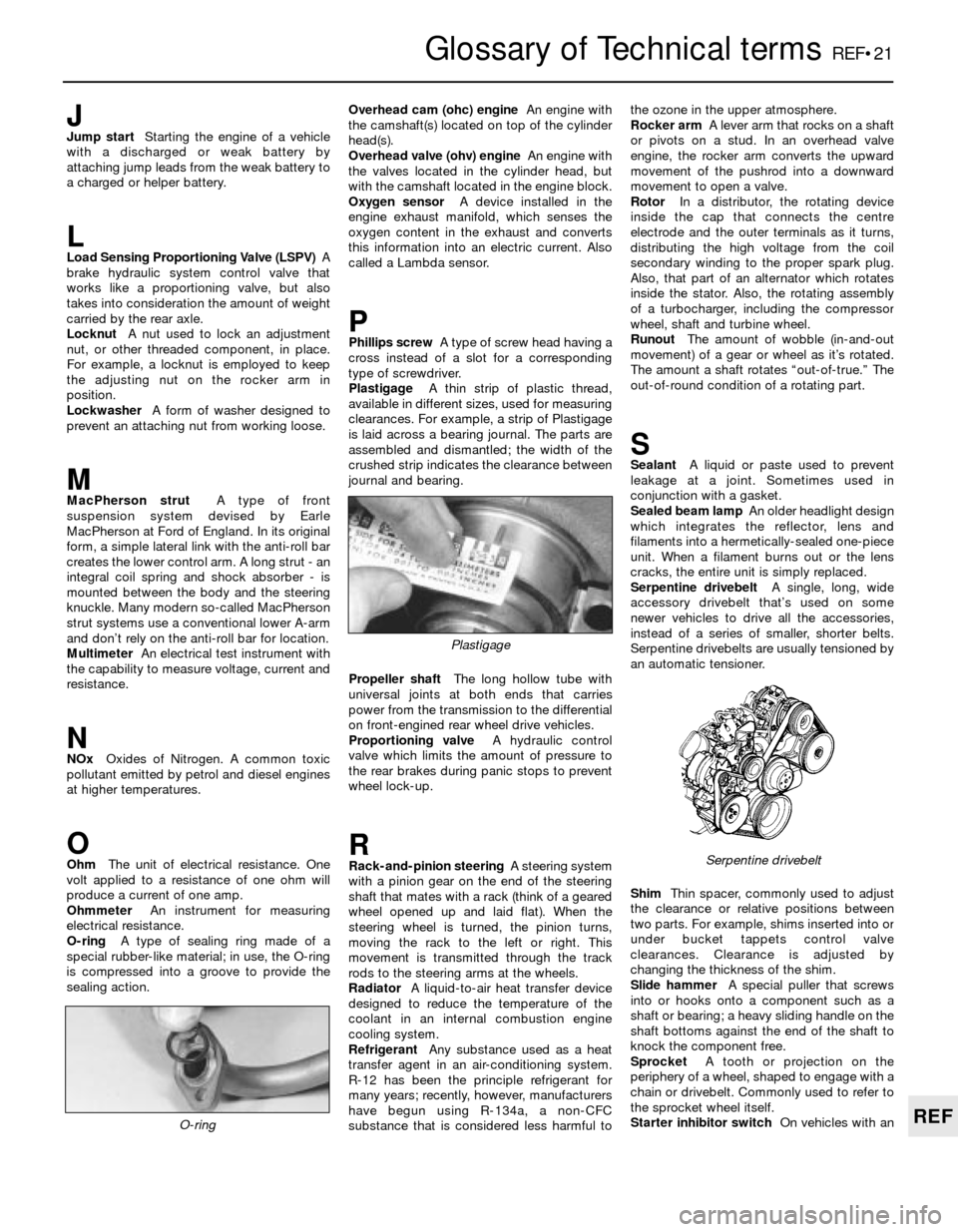weight FORD SIERRA 1992 2.G Reference Workshop Manual
[x] Cancel search | Manufacturer: FORD, Model Year: 1992, Model line: SIERRA, Model: FORD SIERRA 1992 2.GPages: 26, PDF Size: 0.57 MB
Page 1 of 26

General dimensions and Weights . . . . . . . . . . . .REF•1
Buying Spare Parts . . . . . . . . . . . . . . . . . . . . . . .REF•3
Vehicle Identification Numbers . . . . . . . . . . . . . .REF•3
General Repair Procedures . . . . . . . . . . . . . . . . .REF•4
Tools and Working Facilities . . . . . . . . . . . . . . . .REF•5MOT Test Checks . . . . . . . . . . . . . . . . . . . . . . . .REF•7
Fault Diagnosis . . . . . . . . . . . . . . . . . . . . . . . . .REF•11
Glossary of Technical Terms . . . . . . . . . . . . . . .REF•18
Index . . . . . . . . . . . . . . . . . . . . . . . . . . . . . . . . .REF•23
ReferenceREF•1
REF
General dimensions and weights
Dimensions
Overall length:
Saloon . . . . . . . . . . . . . . . . . . . . . . . . . . . . . . . . . . . . . . . . . . . . . . . . . 4467.0 mm (176.0 in)
Hatchback:
All models up to 1987 except GLS, 2.0iS and Ghia . . . . . . . . . . . . 4407.0 mm (173.6 in)
GLS and 2.0iS models up to 1987 . . . . . . . . . . . . . . . . . . . . . . . . . 4460.0 mm (175.7 in)
Ghia models up to 1987 and all models from 1987 . . . . . . . . . . . . 4425.0 mm (174.3 in)
Estate:
All models up to 1987 except Ghia . . . . . . . . . . . . . . . . . . . . . . . . . 4506.0 mm (177.5 in)
Ghia models up to 1987 . . . . . . . . . . . . . . . . . . . . . . . . . . . . . . . . . 4522.0 mm (178.2 in)
All models from 1987 . . . . . . . . . . . . . . . . . . . . . . . . . . . . . . . . . . . 4511.0 mm (177.7 in)
P100 . . . . . . . . . . . . . . . . . . . . . . . . . . . . . . . . . . . . . . . . . . . . . . . . 4900.0 mm (193.1 in)
Overall width:
All models up to 1987 except Base, GLS, 2.0iS and Ghia . . . . . . . . . 1867.0 mm (73.6 in)
Base models up to 1987 . . . . . . . . . . . . . . . . . . . . . . . . . . . . . . . . . . . 1821.0 mm (71.7 in)
GLS, 2.0iS and Ghia models up to 1987 . . . . . . . . . . . . . . . . . . . . . . 1920.0 mm (75.6 in)
All models from 1987 except P100 . . . . . . . . . . . . . . . . . . . . . . . . . . . 1694.0 mm (66.7 in)
P100 . . . . . . . . . . . . . . . . . . . . . . . . . . . . . . . . . . . . . . . . . . . . . . . . . . 1920.0 mm (75.6 in)
Saloon models from 1990 . . . . . . . . . . . . . . . . . . . . . . . . . . . . . . . . . . 1698.0 mm (66.9 in)
Hatchback models from 1990 . . . . . . . . . . . . . . . . . . . . . . . . . . . . . . . 1694.0 mm (66.7 ln)
Estate models from 1990 . . . . . . . . . . . . . . . . . . . . . . . . . . . . . . . . . . 1720.0 mm (67.8 in)
Overall height:
Saloon:
All models except GLS . . . . . . . . . . . . . . . . . . . . . . . . . . . . . . . . . . 1359.0 mm (53.5 in)
GLS models . . . . . . . . . . . . . . . . . . . . . . . . . . . . . . . . . . . . . . . . . . 1352.0 mm (53.3 in)
Models from 1990 . . . . . . . . . . . . . . . . . . . . . . . . . . . . . . . . . . . . . . 1407.0 mm (55.4 in)
Hatchback:
All models up to 1987 except GLS and 2.0iS . . . . . . . . . . . . . . . . . 1420.0 mm (55.9 in)
GLS and 2.0iS models up to 1987 . . . . . . . . . . . . . . . . . . . . . . . . . 1392.0 mm (54.8 in)
All models from 1987 except GLS . . . . . . . . . . . . . . . . . . . . . . . . . 1359.0 mm (53.5 in)
GLS models from 1987 . . . . . . . . . . . . . . . . . . . . . . . . . . . . . . . . . . 1352.0 mm (53.3 in)
Models from 1990 . . . . . . . . . . . . . . . . . . . . . . . . . . . . . . . . . . . . . 1407.0 mm (55.4 in)
Estate:
All models up to 1987 except Base and Ghia . . . . . . . . . . . . . . . . . 1443.0 mm (56.9 in)
Base models up to 1987 . . . . . . . . . . . . . . . . . . . . . . . . . . . . . . . . . 1417.0 mm (55.8 in)
Ghia models up to 1987 . . . . . . . . . . . . . . . . . . . . . . . . . . . . . . . . . 1506.0 mm (59.3 in)
Models from 1987 . . . . . . . . . . . . . . . . . . . . . . . . . . . . . . . . . . . . . . 1386.0 mm (54.6 in)
Models from 1990 . . . . . . . . . . . . . . . . . . . . . . . . . . . . . . . . . . . . . . 1428.0 mm (56.3 in)
P100 . . . . . . . . . . . . . . . . . . . . . . . . . . . . . . . . . . . . . . . . . . . . . . . . 1520.0 mm (59.9 in)
Weights
Kerb weight†:
Saloon:
Models before 1990 . . . . . . . . . . . . . . . . . . . . . . . . . . . . . . . . . . . . 1025 to 1135 kg (2260 to 2503 lbs)
Models from 1990 . . . . . . . . . . . . . . . . . . . . . . . . . . . . . . . . . . . . . . 1065 to 1240 kg (2343 to 2728 lbs)
Hatchback:
Models before 1990 . . . . . . . . . . . . . . . . . . . . . . . . . . . . . . . . . . . . 1010 to 1145 kg (2227 to 2525 lbs)
Models from 1990 . . . . . . . . . . . . . . . . . . . . . . . . . . . . . . . . . . . . . . 1065 to 1240 kg (2343 to 2728 lbs)
Estate:
Models before 1990 . . . . . . . . . . . . . . . . . . . . . . . . . . . . . . . . . . . . 1065 to 1186 kg (2348 to 2613 lbs)
Models from 1990 . . . . . . . . . . . . . . . . . . . . . . . . . . . . . . . . . . . . . . 1105 to 1190 kg (2431 to 2618 lbs)
P100 . . . . . . . . . . . . . . . . . . . . . . . . . . . . . . . . . . . . . . . . . . . . . . . . . . 1370 kg (3021 lbs)
Maximum gross vehicle weight . . . . . . . . . . . . . . . . . . . . . . . . . . . . . . . Refer to VIN plate
Maximum roof rack load . . . . . . . . . . . . . . . . . . . . . . . . . . . . . . . . . . . . . 75 kg (165 lbs)
Minimum towing hitch downward load . . . . . . . . . . . . . . . . . . . . . . . . . . 25 kg (55 lbs)
Maximum towing hitch downward load . . . . . . . . . . . . . . . . . . . . . . . . . 50 kg (110 lbs)
†Exact kerb weights depend upon model and specification
Page 2 of 26

REF•2
Vehicle identification number (VIN) plate details
1 Type approval number
2 Vehicle identification number (VIN)
3 Gross vehicle weight
4 Gross train weight
5 Permitted front axle loading6 Permitted rear axle loading
7 LHD or RHD
8 Engine code
9 Transmission code
10 Final drive code11 Interior trim code
12 Vehicle type number
13 Blank
14 Paint code
15 Blank
Page 15 of 26

Excessive final drive noise
MOil level low, or incorrect grade (Chapter 1)
MWorn bearings (Chapter 9)
MWorn or badly adjusted crownwheel and pinion (Chapter 9)
MLoose or deteriorated final drive mountings (Chapter 9)
Oil leakage from final drive
MPinion or output flange oil seal leaking (Chapter 9)MRear cover leaking (Chapter 9)
MCover or casing cracked (Chapter 9)
Grating, knocking or vibration from driveshafts
MFlange screws loose (Chapter 9)
MCV joints worn (Chapter 9)
MDriveshaft bent (Chapter 9)
Note:Before assuming that a brake problem exists, make sure that the
tyres are in good condition and correctly inflated, that the front wheel
alignment is correct, and that the vehicle is not loaded with weight in an
unequal manner. Apart from checking the condition of all pipe and
hose connections, any faults occurring on the anti-lock braking system
should be referred to a Ford dealer for diagnosis.
Vehicle pulls to one side under braking
MWorn, defective, damaged or contaminated front or rear brake
pads on one side (Chapters 1 and 10).
MSeized or partially-seized front or rear brake caliper piston
(Chapter 10).
MA mixture of brake pad lining materials fitted between sides
(Chapter 10).
MBrake caliper mounting bolts loose (Chapter 10).
MWorn or damaged steering or suspension components (Chapters 1
and 11).
Noise (grinding or high-pitched squeal) when brakes
applied
MBrake pad friction lining material worn down to metal backing
(Chapters 1 and 10).
MExcessive corrosion of brake disc - may be apparent after the
vehicle has been standing for some time (Chapters 1 and 10).
Excessive brake pedal travel
MFaulty master cylinder (Chapter 10).
MAir in hydraulic system (Chapter 10).MFaulty vacuum servo unit (Chapter 10).
Brake pedal feels spongy when depressed
MAir in hydraulic system (Chapter 10).
MDeteriorated flexible rubber brake hoses (Chapters 1 and 10).
MMaster cylinder mountings loose (Chapter 10).
MFaulty master cylinder (Chapter 10).
Excessive brake pedal effort required to stop vehicle
MFaulty vacuum servo unit (Chapter 10).
MDisconnected, damaged or insecure brake servo vacuum hose
(Chapters 1 and 10).
MPrimary or secondary hydraulic circuit failure (Chapter 10).
MSeized brake caliper piston(s) (Chapter 10).
MBrake pads incorrectly fitted (Chapter 10).
MIncorrect grade of brake pads fitted (Chapter 10).
MBrake pads contaminated (Chapter 10).
Judder felt through brake pedal or steering wheel
when braking
MExcessive run-out or distortion of brake disc(s) (Chapter 10).
MBrake pad linings worn (Chapters 1 and 10).
MBrake caliper mounting bolts loose (Chapter 10).
MWear in suspension or steering components or mountings
(Chapters 1 and 11).
Pedal pulsates when braking hard
MNormal feature of ABS - no fault
Clunking or knocking noise when taking up drive
MWorn universal joints (Chapter 8).
MLoose flange bolt (Chapter 8).
Vibration when accelerating or decelerating
MWorn centre bearing or universal joints (Chapter 8).
MBent or distorted shaft (Chapter 8).
MDeteriorated rubber insulator on centre bearing ( Chapter 8)
Engine will not start in any gear, or starts in gears
other than Park or Neutral
MFaulty starter inhibitor switch (Chapter 7).
MIncorrect selector adjustment (Chapter 7).
Transmission slips, shifts roughly, is noisy, or has no
drive in forward or reverse gears
MThere are many probable causes for the above problems, but the
home mechanic should be concerned with only one possibility - fluid
level. Before taking the vehicle to a dealer or transmission specialist,
check the fluid level and condition of the fluid as described in Chapter
1. Correct the fluid level as necessary, or change the fluid and filter if
needed. If the problem persists, professional help will be necessary.
Fault diagnosisREF•15
REF
Propeller shaft
Final drive and driveshafts
Braking system
Page 21 of 26

Glossary of Technical termsREF•21
REF
JJump startStarting the engine of a vehicle
with a discharged or weak battery by
attaching jump leads from the weak battery to
a charged or helper battery.
LLoad Sensing Proportioning Valve (LSPV)A
brake hydraulic system control valve that
works like a proportioning valve, but also
takes into consideration the amount of weight
carried by the rear axle.
LocknutA nut used to lock an adjustment
nut, or other threaded component, in place.
For example, a locknut is employed to keep
the adjusting nut on the rocker arm in
position.
LockwasherA form of washer designed to
prevent an attaching nut from working loose.
MMacPherson strutA type of front
suspension system devised by Earle
MacPherson at Ford of England. In its original
form, a simple lateral link with the anti-roll bar
creates the lower control arm. A long strut - an
integral coil spring and shock absorber - is
mounted between the body and the steering
knuckle. Many modern so-called MacPherson
strut systems use a conventional lower A-arm
and don’t rely on the anti-roll bar for location.
MultimeterAn electrical test instrument with
the capability to measure voltage, current and
resistance.
NNOxOxides of Nitrogen. A common toxic
pollutant emitted by petrol and diesel engines
at higher temperatures.
OOhmThe unit of electrical resistance. One
volt applied to a resistance of one ohm will
produce a current of one amp.
OhmmeterAn instrument for measuring
electrical resistance.
O-ringA type of sealing ring made of a
special rubber-like material; in use, the O-ring
is compressed into a groove to provide the
sealing action.Overhead cam (ohc) engineAn engine with
the camshaft(s) located on top of the cylinder
head(s).
Overhead valve (ohv) engineAn engine with
the valves located in the cylinder head, but
with the camshaft located in the engine block.
Oxygen sensorA device installed in the
engine exhaust manifold, which senses the
oxygen content in the exhaust and converts
this information into an electric current. Also
called a Lambda sensor.
PPhillips screwA type of screw head having a
cross instead of a slot for a corresponding
type of screwdriver.
PlastigageA thin strip of plastic thread,
available in different sizes, used for measuring
clearances. For example, a strip of Plastigage
is laid across a bearing journal. The parts are
assembled and dismantled; the width of the
crushed strip indicates the clearance between
journal and bearing.
Propeller shaftThe long hollow tube with
universal joints at both ends that carries
power from the transmission to the differential
on front-engined rear wheel drive vehicles.
Proportioning valveA hydraulic control
valve which limits the amount of pressure to
the rear brakes during panic stops to prevent
wheel lock-up.
RRack-and-pinion steeringA steering system
with a pinion gear on the end of the steering
shaft that mates with a rack (think of a geared
wheel opened up and laid flat). When the
steering wheel is turned, the pinion turns,
moving the rack to the left or right. This
movement is transmitted through the track
rods to the steering arms at the wheels.
RadiatorA liquid-to-air heat transfer device
designed to reduce the temperature of the
coolant in an internal combustion engine
cooling system.
RefrigerantAny substance used as a heat
transfer agent in an air-conditioning system.
R-12 has been the principle refrigerant for
many years; recently, however, manufacturers
have begun using R-134a, a non-CFC
substance that is considered less harmful tothe ozone in the upper atmosphere.
Rocker armA lever arm that rocks on a shaft
or pivots on a stud. In an overhead valve
engine, the rocker arm converts the upward
movement of the pushrod into a downward
movement to open a valve.
RotorIn a distributor, the rotating device
inside the cap that connects the centre
electrode and the outer terminals as it turns,
distributing the high voltage from the coil
secondary winding to the proper spark plug.
Also, that part of an alternator which rotates
inside the stator. Also, the rotating assembly
of a turbocharger, including the compressor
wheel, shaft and turbine wheel.
RunoutThe amount of wobble (in-and-out
movement) of a gear or wheel as it’s rotated.
The amount a shaft rotates “out-of-true.” The
out-of-round condition of a rotating part.
SSealantA liquid or paste used to prevent
leakage at a joint. Sometimes used in
conjunction with a gasket.
Sealed beam lampAn older headlight design
which integrates the reflector, lens and
filaments into a hermetically-sealed one-piece
unit. When a filament burns out or the lens
cracks, the entire unit is simply replaced.
Serpentine drivebeltA single, long, wide
accessory drivebelt that’s used on some
newer vehicles to drive all the accessories,
instead of a series of smaller, shorter belts.
Serpentine drivebelts are usually tensioned by
an automatic tensioner.
ShimThin spacer, commonly used to adjust
the clearance or relative positions between
two parts. For example, shims inserted into or
under bucket tappets control valve
clearances. Clearance is adjusted by
changing the thickness of the shim.
Slide hammerA special puller that screws
into or hooks onto a component such as a
shaft or bearing; a heavy sliding handle on the
shaft bottoms against the end of the shaft to
knock the component free.
SprocketA tooth or projection on the
periphery of a wheel, shaped to engage with a
chain or drivebelt. Commonly used to refer to
the sprocket wheel itself.
Starter inhibitor switchOn vehicles with an
O-ring
Serpentine drivebelt
Plastigage
Page 23 of 26

AAccelerator cable- 4A•8
Accelerator pedal- 4A•8
Acknowledgements- 0•4
Aerial- 13•20
Air cleaner- 1•18, 1•19, 4A•4, 4B•4
Air conditioning systems- 1•16, 3•1 et seq
Airflow meter- 4B•8
Alarm system- 13•19
Alternator- 5•6
Anti-roll bars- 11•6, 11•13
Anti-theft alarm- 13•19
Antifreeze- 0•17, 1•21, 3•3
ATF- 0•17, 1•3
Automatic transmission- 7B•1 et seq
extension housing oil seal - 7B•5
fault diagnosis - REF•11, REF•14
fluid - 0•17, 1•3
fluid checks - 1•13
gear selector mechanism - 7B•5
kickdown cable - 7B•3
removal and refitting - 7B•2
reversing lamp switch - 7B•6
selector rod - 7B•5
starter inhibitor switch - 7B•6
vacuum diaphragm unit - 7B•6
Auxiliary drivebelts- 1•14, 1•21
Auxiliary shaft- 2A•18
BBattery- 0•15, 1•15, 5•5
Bearings (engine) - 2A•23, 2B•17, 2C•23
Bleeding the power steering- 11•18
Bleeding the brakes- 10•2
Body damage- 12•2, 12•4
Body electrical systems - 13•1 et seq
Bodywork and fittings- 12•1 et seq
Bonnet release cable- 12•4
Bonnet lock- 12•4, 12•5
Boot lid lock- 12•5
Brake checks- 1•10
Brake fluid- 0•13, 0•1, 1•21
Braking system- 10•1 et seq
backplate - 10•12
bleeding the brakes - 10•2
brake caliper - 10•8, 10•10
brake disc - 10•3, 10•11
brake drum - 10•12
brake fluid pipes and hoses - 10•19
brake fluid reservoir - 10•15
brake lamp switch - 13•6
brake pads - 10•3
brake pedal - 10•22
brake shoes - 10•6
computer module (ABS) - 10•17
deceleration valve - 10•18
fault diagnosis - REF•11, REF•15
handbrake adjustment - 1•16, 10•20, 10•21
handbrake cables - 1•16, 10•20, 10•21
handbrake lever - 10•22
hoses brake - 10•19
hydraulic unit pressure switch - 10•17
hydraulic unit/pump/motor (ABS) - 10•15, 10•16
load apportioning valve - 10•19master cylinder (brake) - 10•13
pressure switch - 10•17
vacuum servo unit - 10•14
valve block (ABS) - 10•17
wheel cylinder - 10•12
wheel sensor - 10•18
Bulbs exterior- 13•16
Bulbs interior- 13•10
Bulbs ratings- 13•2
Bumpers- 12•13
Buying spare parts - REF•3
CCables:
accelerator - 4A•8
bonnet release - 12•4
clutch - 6•2
handbrake - 10•20, 10•21
kickdown - 7B•3
speedometer - 13•11
tailgate/boot lid/filler cap - 12•6
Caliper (brake) front/rear- 10•8, 10•10
Camshaft and followers- 2A•17, 2B•14, 2C•16
Capacities- 1•3
Carburettor:
Ford VV type - 1•12, 4A•8, 4A•13
Pierburg 2V type - 1•12, 4A•8, 4A•14
Weber 2V type - 1•12, 4A•8, 4A•14
Weber 2V TLD type - 1•12, 4A•8, 4A•15
Cargo area- 12•10
Carpets- 12•2
Catalytic converter- 4B•3, 4B•14
Central locking system- 13•18
Centre/overhead console- 12•18, 12•19
CFI unit- 4B•10
Charging system- 5•5
Cigarette lighter- 13•6
Clock- 13•6
Clutch- 6•1 et seq
assembly - 6•3
cable - 6•2
fault diagnosis - REF•11, REF•14
pedal - 6•2
release bearing - 6•5
Coil- 5•13
Coil spring (rear) - 11•10
Compression test- 2A•7
Computer module (ABS)- 10•17
Connecting rods- 2A•22, 2B•17, 2C•21
Contents- 0•2
Coolant- 0•12, 0•17, 1•21, 3•3
Coolant level- 0•12
Cooling, heating and air conditioning
systems- 3•1 et seq
antifreeze - 0•12, 0•17, 1•21, 3•3
coolant pump - 3•5
coolant temperature sender and sensor - 3•8
cooling fan - 3•7
draining - 1•21
drivebelt tensioner - 3•7
expansion tank/coolant sensor - 3•8
fan (radiator) - 3•7
fault diagnosis - REF•11, REF•13
filling - 1•21
flushing - 1•21heater - 3•9
radiator - 3•3
switches - 3•8
temperature gauge and sender unit - 3•8
thermostat - 3•4
Courtesy lamp switch- 13•5
Crankshaft oil seals- 2A•19, 2B•15, 2C•19
Crankshaft bearings- 2A•23, 2B•17, 2C•23
Cylinder bores- 2A•24
Cylinder head- 2A•14, 2B•10, 2C•13
DDents- 12•2
Depressurising fuel injection system- 4B•4
Dimensions and weights- REF•1
Disc brake - 10•3, 10•11
Distributor- 5•14, 5•15, 5•16
Door- 12•6
Door inner trim panel- 12•7
Door mirror switch- 13•5
Drivebelts check- 1•14, 1•21, 3•7
Driveplate- 2A•18, 2B•15, 2C•19
Driveshafts:
check - 1•17
fault diagnosis - REF•11, REF•15
overhaul - 9•5
removal and refitting - 9•4
Drum (brake)- 10•12
EEarth fault finding- 13•3
Electric windows- 13•18
Electrical fault finding- 13•2
Electrical system (body)- 13•1 et seq
Electrical system:
weekly checks - 0•14
fault diagnosis - REF•11, REF•16
Electronic vacuum regulator- 4B•11
Engine:
auxiliary shaft - 2A•18
bearings - 2A•23, 2B•17, 2C•23
bores - 2A•24
camshaft followers - 2A•17, 2B•14, 2C•16
codes - 2A•1, 2B•1, 2C•1
compartment views - 0•10, 1•5
compression test - 2A•7
connecting rods - 2A•22, 2B•17, 2C•21
crankshaft bearings - 2A•23, 2B•17, 2C•23
crankshaft oil seals - 2A•19, 2B•15, 2C•19
cylinder bores - 2A•24
cylinder head - 2A•14, 2B•10, 2C•13
dismantling - 2A•11, 2B•8, 2C•10
DOHC engines- 2B•1 et seq
driveplate - 2A•18, 2B•15, 2C•19
fault diagnosis - REF•11, REF•12
flywheel - 2A•18, 2B•15, 2C•19
main bearings - 2A•23, 2B•17, 2C•23
mountings - 2A•11, 2B•7, 2C•9
oils - 0•17, 1•3
oil and filter renewal - 1•9
oil level - 0•12
oil pump - 2A•21, 2B•16, 2C•20
oil seals crankshaft - 2A•19, 2B•15, 2C•19
piston - 2A•22, 2B•17, 2C•21
IndexREF•23
REF
Note: References throughout this index are in the form - “Chapter number” • “page number”